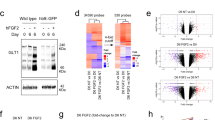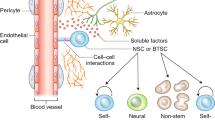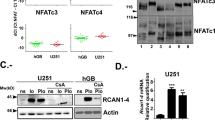Abstract
FGF-2 has been implicated in the neoplastic transformation of glioma cells and in the transition of normal quiescent astrocytes to a proliferating, reactive state. In the present study we have observed that in human glial cells, levels and subcellular localization of FGF-2 are different in quiescent and proliferating cells. FGF-2 was detected in the cytoplasm of non-reactive astrocytes in human brain sections. In contrast FGF-2 was located within the cytoplasm and nuclei of reactive astrocytes in gliotic brain tissue and in neoplastic cells of glioma tumors. In vitro, FGF-2 was found predominantly in the nucleus of subconfluent proliferating astrocytes, but was detected only in the cytoplasm of density arrested quiescent astrocytes. Our results suggest that reduced cell contact stimulates nuclear accumulation of FGF-2, accompanying mitotic activation of reactive human astrocytes. FGF-2 was constitutively localized to the nucleus of continuously proliferating glioma cells independent of cell density. A role for intracellular FGF-2 was further suggested by the observation that glioma cells that are not stimulated to proliferate by extracellular FGF-2 proliferated faster when transfected with FGF-2 expressing vectors. This increased proliferation correlated with nuclear accumulation of FGF-2. Cell proliferation was attenuated by 5′-deoxy-5′-methylthioadenosine, a FGF-2 receptor tyrosine kinase inhibitor that acts within the cell, but was unaffected by myo-inositol hexakis [dihydrogen phosphate] that disrupts FGF-2 binding to plasma membrane receptors. Our results indicate that FGF-2 serves as a nuclear regulator of proliferation in astrocytic cells. In glioma cells, the constitutive presence of FGF-2 in the nucleus may promote proliferation that is insensitive to cell contact inhibition.
This is a preview of subscription content, access via your institution
Access options
Subscribe to this journal
Receive 50 print issues and online access
$259.00 per year
only $5.18 per issue
Buy this article
- Purchase on Springer Link
- Instant access to full article PDF
Prices may be subject to local taxes which are calculated during checkout
Similar content being viewed by others
Author information
Authors and Affiliations
Rights and permissions
About this article
Cite this article
Joy, A., Moffet, J., Neary, K. et al. Nuclear accumulation of FGF-2 is associated with proliferation of human astrocytes and glioma cells. Oncogene 14, 171–183 (1997). https://doi.org/10.1038/sj.onc.1200823
Received:
Revised:
Accepted:
Issue Date:
DOI: https://doi.org/10.1038/sj.onc.1200823
Keywords
This article is cited by
-
Identification of ITPR1 as a Hub Gene of Group 3 Medulloblastoma and Coregulated Genes with Potential Prognostic Values
Journal of Molecular Neuroscience (2022)
-
3D Astrogliosis Model with bFGF and GFAP Expression Profiles Corresponding to an MCAO-injured Brain
Biotechnology and Bioprocess Engineering (2018)
-
Dual Functional MicroRNA-186-5p Targets both FGF2 and RelA to Suppress Tumorigenesis of Glioblastoma Multiforme
Cellular and Molecular Neurobiology (2017)
-
Astrocytoma simultaneously present with Meningioma-a report of two cases and review of the literature
Chinese Neurosurgical Journal (2016)
-
IGFBP2 potentiates nuclear EGFR–STAT3 signaling
Oncogene (2016)



